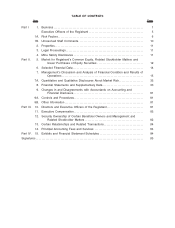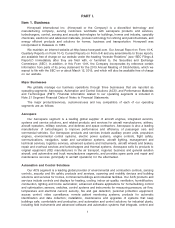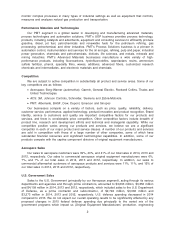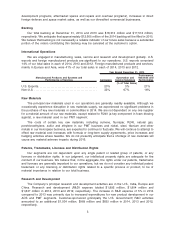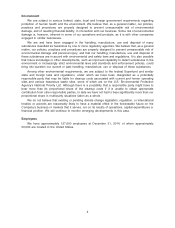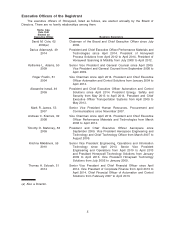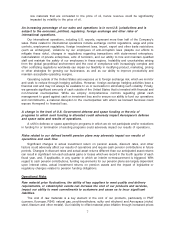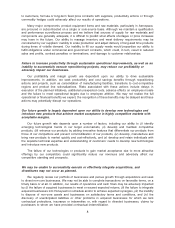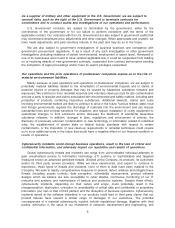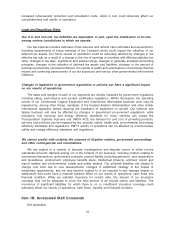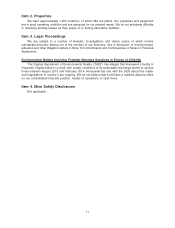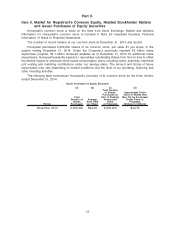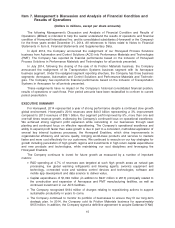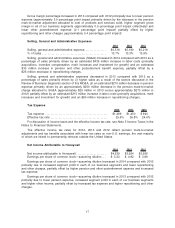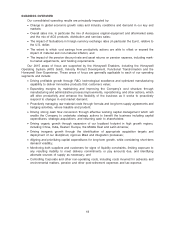Honeywell 2014 Annual Report Download - page 17
Download and view the complete annual report
Please find page 17 of the 2014 Honeywell annual report below. You can navigate through the pages in the report by either clicking on the pages listed below, or by using the keyword search tool below to find specific information within the annual report.to customers, formula or long-term fixed price contracts with suppliers, productivity actions or through
commodity hedges could adversely affect our results of operations.
Many major components, product equipment items and raw materials, particularly in Aerospace,
are procured or subcontracted on a single or sole-source basis. Although we maintain a qualification
and performance surveillance process and we believe that sources of supply for raw materials and
components are generally adequate, it is difficult to predict what effects shortages or price increases
may have in the future. Our ability to manage inventory and meet delivery requirements may be
constrained by our suppliers’ inability to scale production and adjust delivery of long-lead time products
during times of volatile demand. Our inability to fill our supply needs would jeopardize our ability to
fulfill obligations under commercial and government contracts, which could, in turn, result in reduced
sales and profits, contract penalties or terminations, and damage to customer relationships.
Failure to increase productivity through sustainable operational improvements, as well as an
inability to successfully execute repositioning projects, may reduce our profitability or
adversely impact our businesses.
Our profitability and margin growth are dependent upon our ability to drive sustainable
improvements. In addition, we seek productivity and cost savings benefits through repositioning
actions and projects, such as consolidation of manufacturing facilities, transitions to cost-competitive
regions and product line rationalizations. Risks associated with these actions include delays in
execution of the planned initiatives, additional unexpected costs, adverse effects on employee morale
and the failure to meet operational targets due to employee attrition. We may not realize the full
operational or financial benefits we expect, the recognition of these benefits may be delayed and these
actions may potentially disrupt our operations.
Our future growth is largely dependent upon our ability to develop new technologies and
introduce new products that achieve market acceptance in highly competitive markets with
acceptable margins.
Our future growth rate depends upon a number of factors, including our ability to (i) identify
emerging technological trends in our target end-markets, (ii) develop and maintain competitive
products, (iii) enhance our products by adding innovative features that differentiate our products from
those of our competitors and prevent commoditization of our products, (iv) develop, manufacture and
bring new products to market quickly and cost-effectively, and (v) develop and retain individuals with
the requisite technical expertise and understanding of customers’ needs to develop new technologies
and introduce new products.
The failure of our technologies or products to gain market acceptance due to more attractive
offerings by our competitors could significantly reduce our revenues and adversely affect our
competitive standing and prospects.
We may be unable to successfully execute or effectively integrate acquisitions, and
divestitures may not occur as planned.
We regularly review our portfolio of businesses and pursue growth through acquisitions and seek
to divest non-core businesses. We may not be able to complete transactions on favorable terms, on a
timely basis or at all. In addition, our results of operations and cash flows may be adversely impacted
by (i) the failure of acquired businesses to meet or exceed expected returns, (ii) the failure to integrate
acquired businesses into Honeywell on schedule and/or to achieve expected synergies, (iii) the inability
to dispose of non-core assets and businesses on satisfactory terms and conditions, and (iv) the
discovery of unanticipated liabilities or other problems in acquired businesses for which we lack
contractual protections, insurance or indemnities or, with regard to divested businesses, claims by
purchasers to whom we have provided contractual indemnification.
8




